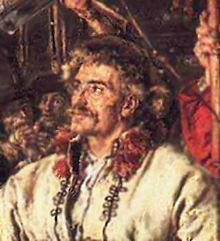Wojciech Bartosz Głowacki

Wojciech Bartos(z) Głowacki (1758–1794), known also as Bartosz Głowacki, was a
Biography
Wojciech Bartosz was born around 1765 as a
In 1783 he married Jadwiga Czernikowa, and they had three daughters (Helena, Cecylia and Justyna). They were poor, and their house collapsed some years before the death of Jadwiga (she was then a widow). Their field was between 4 and 9 morgs, without a horse, and it was only after Bartosz became famous at Racławice that they received a cow and some other animals from Lord Szujski.
Wojciech Bartosz was
Bartosz was chosen as a conscript, ironically, because his lord's administrative staff viewed him as a troublemaker and decided that sending him off to war was a good way to get rid of him. He arrived in the military camp at the beginning of April, and on 4 April he took part in the famous battle of Racławice, where Tadeusz Kościuszko, leader of the Polish uprising, defeated the Russian army. Kosynierzy were vital to the Polish victory, as they swarmed the Russian artillery positions, overrunning them after only a single salvo.

It was at that battle that Bartosz gained fame: he was the first to reach the enemy lines and stopped one of the cannons from shooting by extinguishing its fuse with his cap. For that deed, as well as his pro-uprising rhetoric, Kościuszko promoted him to the rank of
On 6 June 1794 Głowacki took part in the Battle of Szczekociny. Polish forces, 15,000 strong, were defeated by a combined Prussian and Russian army, some 27,000 strong. Głowacki was among the 346 Polish wounded evacuated from battle, but his wounds were too serious, and he died soon afterwards (sometime between 6 and 9 June). He was probably buried in the Church of Najjaśniejsza Maria Panna in Kielce on 9 June.
Fame
Bartosz Głowacki became one of the most famous Polish soldiers of the uprising, and joined the ranks of the Polish national heroes.
References
- ISBN 9789639241091.
- ISBN 0801489962.
